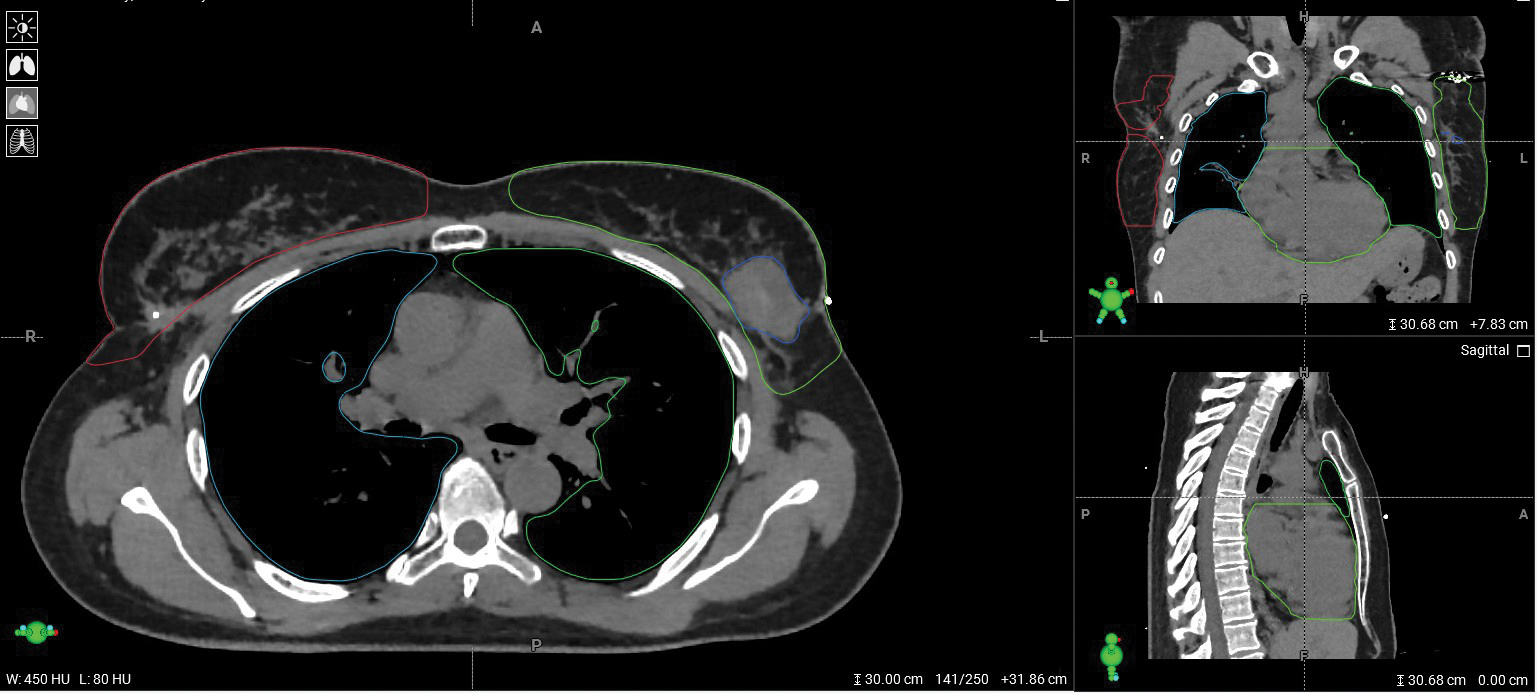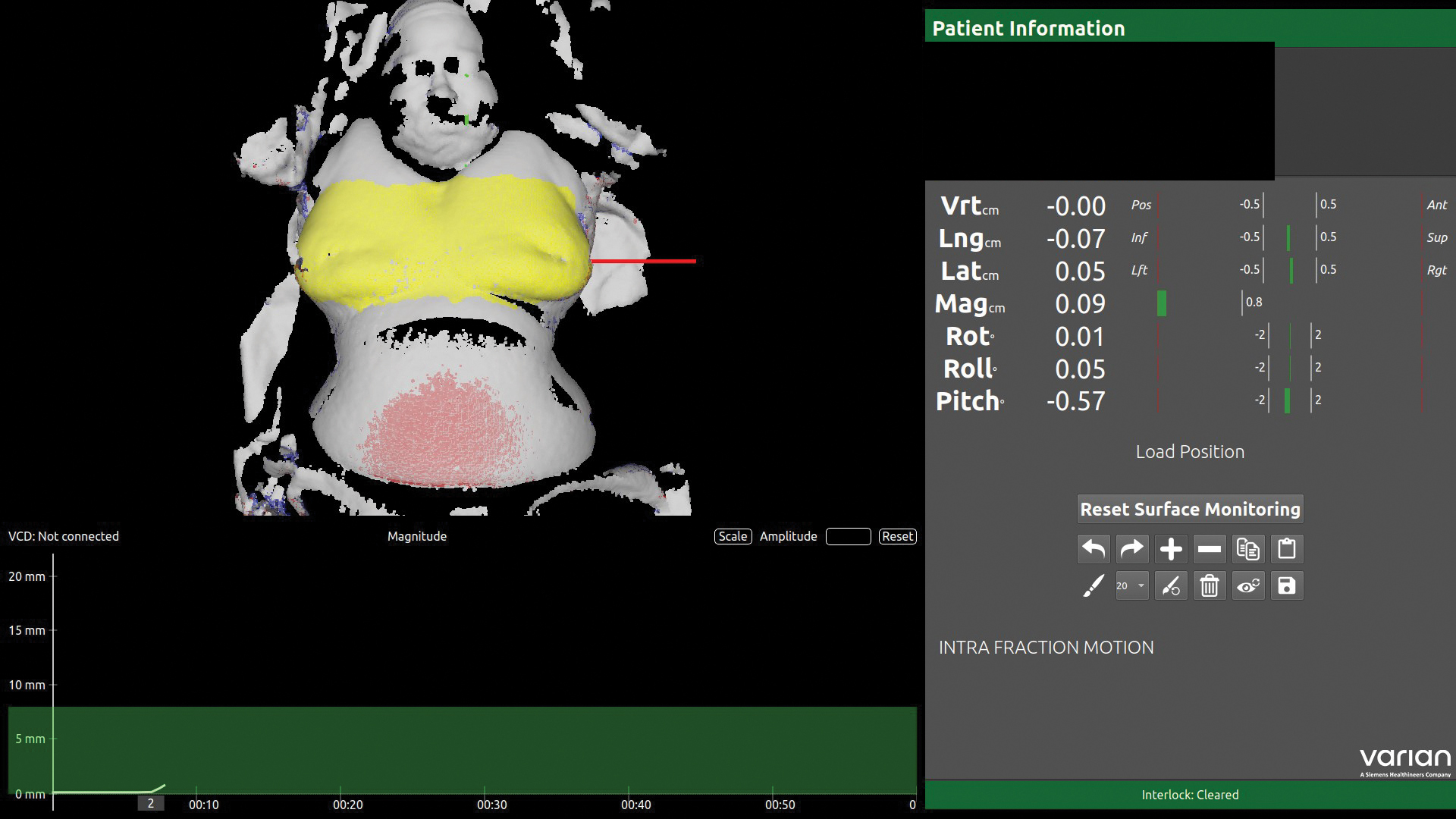UAB Radiation Oncology is excited to announce its new Stereotactic Body Radiation Therapy program for breast cancer patients using adaptive radiotherapy technology.
The majority of women who present with early-stage breast cancer are a candidate for a lumpectomy, which is removal of the breast tissue and sparing of the uninvolved breast. Traditionally, four to six weeks of radiation therapy to the whole breast was required afterward to decrease the chance that the tumor would recur. More recently, for appropriately selected patients, a shorter course of partial breast radiation allows treatment to be completed over five courses. In addition, less of the normal breast is exposed to radiation, which reduces short- and long-term side effects compared to patients getting whole breast radiotherapy.
UAB Department of Radiation Oncology Associate Professor Hunter Boggs, M.D., recently published UAB’s experience with using sterotactic body radiotherapy (SBRT), which is a precise form of radiation treatment to deliver five treatments to the lumpectomy cavity.
“The ability to reduce the surrounding dose to the uninvolved breast resulted in excellent short-term cosmetic outcomes in our study. We are still collecting data regarding long-term side effects,” said Boggs. “However, one of the issues that we would find is that the fluid collection, called a seroma, left at time of lumpectomy will shift and often shrink as the treatments progressed. The area of breast tissue surrounding the seroma is the target area of treatment for partial breast irradiation after a lumpectomy. If we could find a way to shrink our daily treatments to better pinpoint and target the fluid collection, we would be able to further decrease the amount of normal breast treated. We know that reducing the amount of radiation to the uninvolved breast results in improved side effects from treatment.”
 Using an advanced imaging algorithm, Ethos is able to visualize the patient anatomy of today and create a custom radiation plan for that day. This is an example of the imaging utilized by the Ethos system with the seroma outlined in blue.
Using an advanced imaging algorithm, Ethos is able to visualize the patient anatomy of today and create a custom radiation plan for that day. This is an example of the imaging utilized by the Ethos system with the seroma outlined in blue.Adaptive Therapy with Ethos
Enter adaptive therapy, utilizing a linear accelerator system called Ethos by Varian, which was first implemented by the radiation oncology department in August 2021. Ethos is a first-of-its-kind treatment machine that uses advanced imaging and an artificial intelligence (AI) system to assist in plan creation and delivery. “The Ethos is a complete game changer for radiation oncology,” said Assistant Professor Dennis Stanley, Ph.D., lead physicist for the adaptive program. “Utilizing the advanced features of the Ethos allows us to better target tumors but, more importantly, better protect healthy tissues like the breast and heart. With this system we can treat your tumor as it is right now.”
“We draw out the lumpectomy cavity at time of the planning scan,” Boggs explained. “With nonadaptive therapy, we were locked into treating the same volume regardless of how the breast changes from day-to-day. However, with adaptive therapy, we can scan and redraw the lumpectomy cavity in real time while the patient is laying in the treatment position. If the breast and lumpectomy cavity are sufficiently different than our initial scan, we can replan immediately and see if our new plan will result in less dose to the normal breast and other critical organs nearby such as the heart and lung. We do this before every treatment."
According to Boggs and Stanley, UAB is the first institution in the world to treat patients with partial breast stereotactic techniques using daily adaptive replanning. “We have treated a handful of patients using this technique and we plan to examine our cosmetic outcome information over the coming months and years,” said Boggs.
“From a technical standpoint, this treatment option offers tremendous advantage, especially for our breast cancer patients; we look forward to developing this treatment technique even further,” said Stanley.
 Along with the advanced treatment techniques, Ethos utilizes an optical-based surface imaging system, called IDENTIFY, to verify patient positioning and monitor patient movement.
Along with the advanced treatment techniques, Ethos utilizes an optical-based surface imaging system, called IDENTIFY, to verify patient positioning and monitor patient movement.
Next Steps
Regarding next steps, Drs. Boggs and Stanley and the breast radiation oncology team are interested in exploring reducing the number of treatments required for a partial breast treatment.
“We have opened a clinical study examining the use of partial breast radiation delivered in a single treatment,” Boggs says. “We think that this will be an attractive option for patients who are looking to reduce the physical burden of coming in for a number of treatments. The adaptive technique will be perfect for this type of treatment given the need to precisely understand the shape of the lumpectomy cavity as well as the breast position prior to the single course of treatment.”
For more information about adaptive radiation therapy for partial breast irradiation, please contact 205-934-5670.